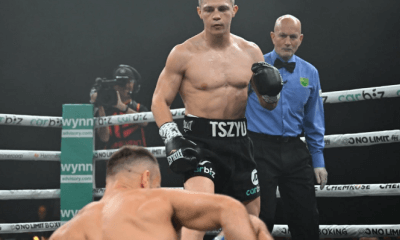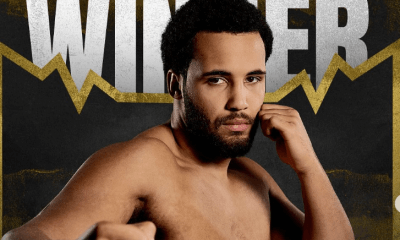Featured Articles
Joe Joyce and Joe Parker meet at the Crossroads and the Likely Winner is….

A meeting at the crossroads is one of the most oft used cliches in boxing, but for a reason. Contests which will help define two careers, especially ones from adjacent generations are rare. Joseph Parker (30-2) knocked out Alexander Dimitrenko, out-pointed Carlos Takam, and received a razor-thin decision win over Andy Ruiz, all before Joe Joyce (14-0) had turned professional. Usually, a meeting between a contender who never reached the very top and an apprentice on the prowl for a legitimate scalp is fought at a junction, not a crossroads; the inexperienced man can dust himself off after any loss and come again. Not so Joyce. 14-0 he may be, but he is also seven years older than Parker, who is thirty. A major setback here could keep Joyce off the championship grass into his forties, and while many will claim forty is the new thirty in heavyweight boxing, this is only true of those who can stomach it.
Getting punched for pay is hard.
Parker, meanwhile, embraces every facet of another common boxing cliché, that of the heavyweight Ronin. Parker has boxed in his native New Zealand just once since 2018 and hasn’t defeated a ranked contender in even longer. Seen with the right kind of eyes, Parker’s record is a mirage, and although he made a spirited effort against Dillian Whyte in July of 2018, his surrender to Anthony Joshua a few months before was meek. Since his desperately narrow victory over Ruiz, Parker is 0-2 versus ranked contenders in six years. Should he drop to 0-3, Parker’s status will be reduced to that of gatekeeper.
So, when these two meet this Saturday night in Manchester, England, it is for more than an ABC trinket. The loser gets linked with Otto Wallin and Martin Bakole; the winner will find himself positioned for a shot at Joshua, Tyson Fury, Oleksandr Usyk and any other monied heavyweights that emerge in 2023.
“Deep down there is respect,” Joyce told Parker nonchalantly at a recent publicity event. “But I want to smash your face in.”
This is Joyce in a nutshell. He is to the point, honest, open and direct when he is at his very best, and a stumbling confusion of speech when he strays from these tenants. Joyce has drawn criticism for the seemingly disinterested monotone with which he answers many questions during interviews or at press events, even seeming to drift off into a deep sleep on one occasion. I personally enjoy it and he recalls for me a manifestation of Norman Mailer’s appraisal of George Foreman. Mailer said of Foreman, “he could be deep, he could be non-responsive…he is a physical guru.” This was a polite way of saying that there could be very little going on in Foreman’s head (wrong, as it turned out) but that his physicality and seeming unassailability more than made up for it.
It would be wrong to compare Joyce to Foreman, but these things can be said of him, also.
“He has height, reach and power,” was how Parker summarised his opponent’s offensive skills. “He’s got a very good engine.”
This last, in combination with a chin which might soon be confirmed granite, is what sets him apart. Joyce cannot be dissuaded in his seek-and-destroy mission, and his being shelled by opponents like Daniel Dubois, Carlos Takam and most recently Christian Hammer has made no more impact than the limited opposition he met upon turning pro in late 2017. Joyce does indeed appear to be a non-responsive physical guru, as non-responsive to punches as he sometimes is to questions. This has earned him the nickname “The Juggernaut” and a very ill-advised attempt to adopt at a ring walked dressed as the Marvel comic-book character of the same name aside, it suits him.
Joyce is the classic big heavyweight, he deploys himself behind a surprisingly good jab and then does his thing: solve him if you can, and if you can’t, you will get hurt.
Joyce claims to have recently had his bone-density checked and that it is five times denser than that of the average man, higher even than that of other elite-level impact athletes who tend to flatten out at three-times the density of the average man. This translates to a real advantage in the ring that Joyce is cognisant of; he would also prefer not to rely upon it quite so much.
“I wasn’t happy getting hit clearly [by Christian Hammer in his most recent fight]. Preferably I won’t get hit by those punches against Parker.”
Parker is no big hitter, but then it was the mind-mixing punches of Muhammad Ali that spun Foreman to the canvas, not the booming shots of Ron Lyle or Joe Frazier. Parker’s best shot is the right-hand over and it is this punch which has most troubled Joyce recently. Taking a tour through Parker’s early finishes (rarer and rarer as his opponents improved) we see a long right hand so often the weapon of destruction. He started Dimitrenko’s trouble with a right-handed feint and then seconds later a distance right-handed punch for which he leans all the way across himself. Parker makes his position the key and this in tandem with some light footwork has spared him the worst attentions of the big punchers he has met. This knockout of Dimitrenko was impressive. Parker was just the second man to do it, and he remains the quickest in getting the giant German out of there (Tony Yoka finally equaled him, knocking him out in three rounds in Dimitrenko’s final fight).
It seemed, in these days, that Parker would manifest as a puncher, an exciting prospect given his skill and his own superb chin. Alas, it was not to be – but for this particular fight, one of Parker’s strengths, the right hand, lines up with Joyce’s specific weakness, a propensity to be hit with the right hand. He simply does not defend expertly against it and given his age and style he probably never will.
This is tantalising thought and hints at potential excitement. Parker taking control of this fight early and hurting Joyce with right hands while keeping out of harm’s way would be a thrilling and attractive opening. Watching Joyce, listed at 6’6 with an 80-inch reach, try to recapture the initiative as Parker inevitably fades would be even more so.
Parker claims this will be his hardest fight, which rings rather hollow if he expects to win, but Joyce’s claim that “this fight raises the bar” does ring true. “I’ll have to fight at a higher level [to win],” the Londoner added and it is a valid question as to whether the face-first tactics we’ve seen Joyce employ against Takam and Hammer will be enough to get the job done against a fundamentally sound fighter of Parker’s experience. People associated with Joyce, including his broadcast partners, have rather nervously been telling each-other and themselves that Joyce won’t fight in that plodding, carefree manner against elite opposition but the hour is getting late for him to demonstrate the truth of this.
Parker claims to have to have reclaimed his passion for boxing under Andy Lee who he has been training with in the United Kingdom, his family awaiting him in New Zealand. Joyce meanwhile travels to Las Vegas to train, taking advantage of the world-class sparring and facilities available to him but inflicting upon himself two trips across the Atlantic. Awaiting him there is Ismael Salas, a trainer Joyce seems wed to, the man who “made Felix Savon” in his own words. The Cuban is unquestionably a truly gifted trainer but if he has made significant differences to Joyce’s game, they are subtle.
Included though is an ability to ride troublesome right-handed punches. This is likely to be the key metric on Saturday. If Joyce is able to lift the sting from Parker’s best shots in the first half of the fight, the fight is decided, whatever the scorecards say at that point. Parker must land his best blows on Joyce, often and early and cleanly.
If he does, then he’s in it, but only if he’s in the very best shape of his career, because the Juggernaut will be coming for him. My guess is that Joyce’s momentum will send Parker into hiding later in the fight and that Joyce will sweep the final four or five rounds. This will be too many. Joyce is sluggish but he is busy and he is huge and that combination is awful enough; the addition of Parker’s best work bouncing off a sliding Joyce’s head and body without great effect will compound the issue.
Parker is tough and savvy. I expect him to be tough and savvy enough to survive the twelve rounds and drop a clear decision in an excellent fight.
To comment on this story in the Fight Forum CLICK HERE
-

 Featured Articles4 weeks ago
Featured Articles4 weeks agoThe Hauser Report: Zayas-Garcia, Pacquiao, Usyk, and the NYSAC
-

 Featured Articles3 weeks ago
Featured Articles3 weeks agoOscar Duarte and Regis Prograis Prevail on an Action-Packed Fight Card in Chicago
-

 Featured Articles2 weeks ago
Featured Articles2 weeks agoThe Hauser Report: Cinematic and Literary Notes
-

 Book Review2 weeks ago
Book Review2 weeks agoMark Kriegel’s New Book About Mike Tyson is a Must-Read
-

 Featured Articles4 weeks ago
Featured Articles4 weeks agoRemembering Dwight Muhammad Qawi (1953-2025) and his Triumphant Return to Prison
-

 Featured Articles1 week ago
Featured Articles1 week agoMoses Itauma Continues his Rapid Rise; Steamrolls Dillian Whyte in Riyadh
-

 Featured Articles3 days ago
Featured Articles3 days agoThe Hauser Report: Debunking Two Myths and Other Notes
-

 Featured Articles3 weeks ago
Featured Articles3 weeks agoRahaman Ali (1943-2025)


















